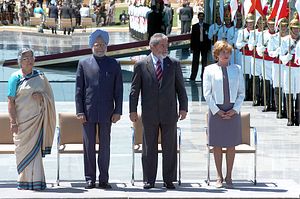For many years, if you asked the average Indian about Latin America, you would receive either a blank look or perhaps mention of the region’s football powerhouses. Likewise for Latin Americans, for whom India was a distant land known for Ayurveda, yoga, and philosophy.
Yet the history is there. Following the Cuban revolution in 1959, for instance, India was one of the few countries to recognize the new regime under Fidel Castro, opening an embassy in Havana the next year. Both countries were members of the Non-Aligned Movement (NAM) and shared a similar worldview. Jawaharlal Nehru was among the first world leaders to visit Havana, with the then Indian prime minister making the trip in 1960. In many ways, Cuba was a gateway to Latin America for India.
By the 1990s, India was beginning to attract international notice for its economic growth, and for beginning to open of its markets to foreign investors. Around the same time, Latin America was beginning to sow the seeds for political and economic stability. Brazil, in particular, began to emerge as one of the region’s star performers. It was among one of the first countries in the region to conclude bilateral agreements with India and later clubbed together with New Delhi in numerous multilateral forums. In 1997, the Indian government launched its FOCUS LAC (Latin America and Caribbean) strategy, hoping to boost exports to the region.
During the Cold War era, the world tended to look at Latin American countries in the context of the United States, and many countries based their policies towards the region on that perspective. After the 2008 financial crisis, though, the resilience shown by emerging Latin America economies such as Brazil forced a rethink, and Latin America became increasingly viewed as a rising regional and economic power in a multipolar world.
Apart from trade and investment, ties with Latin America have much to offer India, in areas such as energy, knowledge sharing, and cooperation in multilateral forums on issues such as climate change and the environment. Brazil and India are already partnering in forums such as BRICS (Brazil, Russia, India, China, South Africa), BASIC (Brazil, South Africa, India, China), and IBSA (India, Brazil, South Africa). New Delhi has also signed preferential trade agreements (PTA) with Chile and MERCOSUR. Yet many Latin American countries (with their huge potential market for services) have not received India’s due attention.
A look at India’s policy towards Latin America over the years is revealing. While many Latin American heads of state have made India an important priority and have visited India, there has been little reciprocity from New Delhi. With a few exceptions—Brazil, Cuba and Chile—Latin American countries have received minimal high-level attention. Most visits to the region have been for multilateral gatherings, such as the Commonwealth Heads of Government Meeting summit at Port of Spain in 2009, the IBSA and BRICS summits in Brazil in 2010, the Rio+20 summit in 2012, and the G-20 summit held in Mexico.
The focus on Brazil is perhaps not surprising, given that both countries are major emerging economies and as such partner in multiple forums, with growing diplomatic interdependence. For instance, Brazil and India are backing each other for a permanent seat in a reformed United Nations Security Council. While most countries may have looked at Latin America through a U.S. prism in the past, India seems to look at the region from a Brazilian perspective.
Trade and economic ties with other countries in the region, such as Venezuela—currently India’s largest trade partner in the region with trade topping $14 billion in 2012/13—as well as Mexico, Argentina, Peru and Colombia are gradually rising. Nonetheless, New Delhi’s emphasis remains resolutely on Brazil.
It is time for that to change. The next Indian government should both act to harness the economic potential of the entire Latin American region, while also leveraging its soft power and strengths in areas like services to bolster its presence within the region.
Tridivesh Singh Maini is associated with the Jindal School of International Affairs, OP Jindal Global University, Sonepat. Sridhar Ramaswamy is a final year Master’s student of Foreign Policy, with the Jindal School of International Affairs, OP Jindal Global University, Sonepat.































